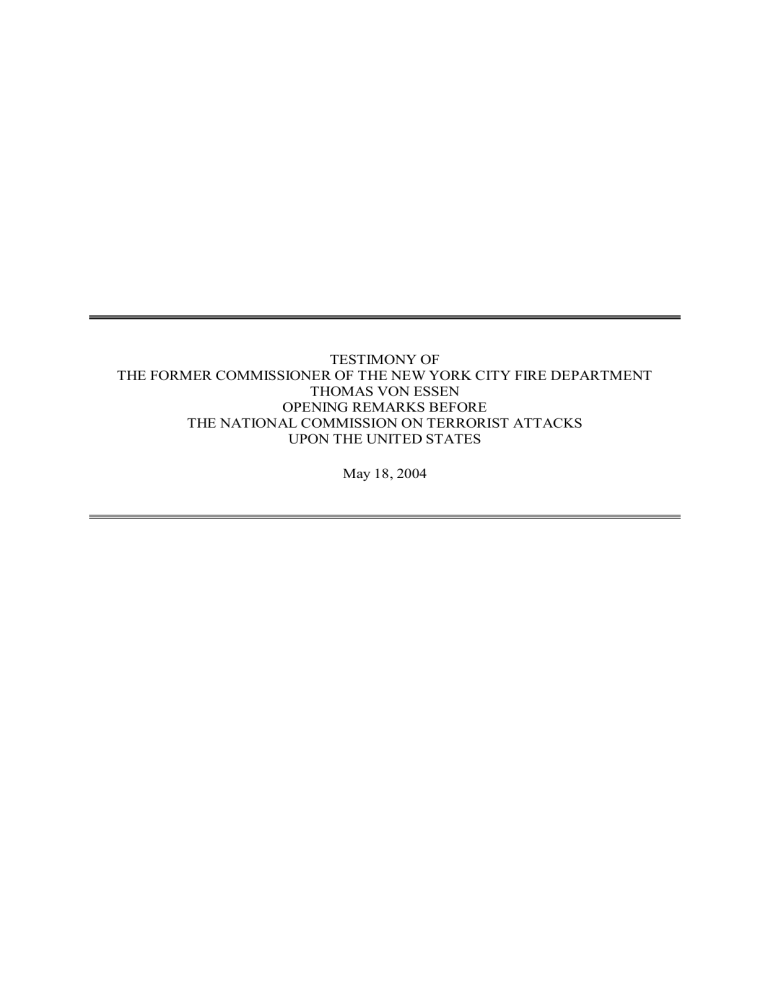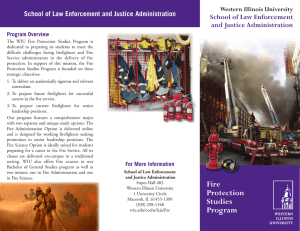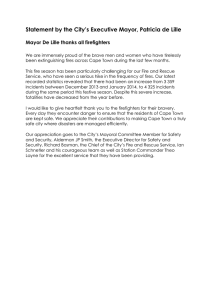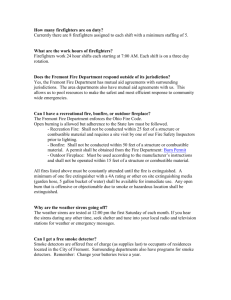TESTIMONY OF THOMAS VON ESSEN

TESTIMONY OF
THE FORMER COMMISSIONER OF THE NEW YORK CITY FIRE DEPARTMENT
THOMAS VON ESSEN
OPENING REMARKS BEFORE
THE NATIONAL COMMISSION ON TERRORIST ATTACKS
UPON THE UNITED STATES
May 18, 2004
FORMER COMMISSIONER OF THE NEW YORK CITY FIRE DEPARTMENT
THOMAS VON ESSEN
OPENING REMARKS BEFORE
THE NATIONAL COMMISSION ON TERRORIST ATTACKS
UPON THE UNITED STATES
The New School
New York City
May 18, 2004
Good Morning Commissioners.
Thank you for inviting me to be here today. I welcome this opportunity to share my experiences on September 11, 2001.
I have thought about September 11th, and those who we lost, every day for the last two and a half years. To truly understand what happened in New York City on 9/11 you need more than simply the recounting of events. You also need to understand the people involved and the magnitude of the situation they confronted. Enough time has passed that I fear we have lost a true sense of that day, and the days that followed.
The hundreds of New York City Firefighters, Police Officers, EMS Officers, Port
Authority Police Officers, Emergency Management responders, and other first responders who rushed to the World Trade Center, deserve our praise and unyielding gratitude for their courage and dedication in the face of the greatest disaster in this nation’s history. Their sole purpose that morning was to save lives. They put themselves in harm’s way to help those in need.
That is what firefighters do everyday. That is who they are. We have to make sure that their bravery and valor is fairly and properly represented in this process.
The enormity and ambiguity of the circumstances that morning must also be kept in our minds as we examine the events of 9/11. Two of the tallest buildings in the world were on fire, tens of thousands of people were inside, and the largest rescue operation in history commenced in a matter of minutes. The scope of this catastrophe would multiply drastically, to a scale never seen before by first responders in America. As much preparation, practice and experience as we had, nothing could have ever really prepared us for what happened, or how fast the events would unfold. I say without hesitation, that the men and women of this City, rescue workers and civilians alike, did a phenomenal job that day.
When I arrived at the North Tower of the World Trade Center, soon after it had been hit by the first plane, it was a scene that defied belief. Even after 30 years as a firefighter, I had never witnessed this level of destruction. I knew that we could lose thousands of civilians above the impact area. There was debris and broken glass all over the ground, as well as many obvious casualties.
As I entered the North Tower lobby, Chief of Department Pete Ganci, was on his way out. He had already evaluated the situation in the lobby, and he was establishing a staging area and more strategic command post on West Street, across from and west of the tower. The Chief of Department is the highest-ranking officer in the Fire Department, and he was the overall
Incident Commander. Prior to Chief Ganci’s arrival at the site, Chiefs Joe Pfeifer, Pete Hayden and Joe Callan had established the initial lobby command post in the North Tower. Chief Callan was the highest-ranking chief on the scene in the lobby and he was in charge in the tower. We all knew that this was already the biggest disaster we had ever encountered. But as always, we also knew that we would do what needed to be done, one step at a time.
2
Notwithstanding the conditions, the scene in the tower lobby was relatively calm; it was a combination of control and chaos that is a characteristic of a fire scene. In accordance with our standard practice in hi-rise fires, the chief officers were sending units to gather information, staging the firefighters, and developing a strategy and tactical approach. The first units that had arrived were already climbing the stairs to establish personnel and equipment staging areas on upper floors, others were waiting for their orders. More firefighters and chiefs were arriving all the time to support what was expected to be a very long operation. The units had been dispatched in response to Chief Ganci’s call for a Fifth Alarm – the highest level of mobilization in the Fire Department.
Then, at approximately 9:03, the South Tower was hit. Chief Ganci called a second Fifth
Alarm. Chiefs Donald Burns and Orio Palmer went to the South Tower to set up a third operations post to manage the response there. Instantly, the largest and most difficult rescue operation ever set in motion doubled in size and complexity. Sometime after the second plane hit the South Tower, I left the North Tower lobby and went to the command post on West Street.
Once outside, I looked up, and saw the huge burning hole in the North Tower, and the debris and bodies falling. I’ve heard it said by others, and I knew that every firefighter on the scene was thinking the same thing – how horrible it must have been up there, that people were driven out of the windows by the heat.
Even though I had been a firefighter for many years, my role as Commissioner was not incident command. Fire Commissioner is a civilian post, and one of my many responsibilities was to make sure the Mayor had as full an understanding as possible of the situation we faced.
From the West Street command post I went to join the Mayor, who was already with Police
Commissioner Bernard Kerik and Director of the Office of Emergency Management Richard
3
Sheirer. With the Department Chiefs in command, I knew that the rescue operation at the World
Trade Center was in the most capable hands there were.
These men were the most seasoned and practiced fire chiefs in the nation. They had done hundreds of drills and responded to thousands of emergencies. They knew how to take control of a crisis, how to handle ambiguity, and how to make the critical decisions needed to save lives.
Simply stated – they were the experts. No one could have done a better job.
Was everything perfect? Of course not, it never is in this business. Did they know everything they would have liked to have known? Not at all, they never do in these situations.
As I said before, you have to remember the circumstances they were under. Two Fifth Alarms within fifteen minutes was unheard of until that point. It wasn’t a case study or a tabletop drill.
It was real, fast moving and horrifying. What they were able to accomplish was extraordinary.
Though we suffered great losses, thousands of people were saved. I have no doubt that they did everything they could to ensure the safe evacuation of those buildings, by both civilians and firefighters.
On a technical point, it is important to understand how the Fire Department works when fighting hi-rise fires. We had three command posts, because we needed three; and we located them where they were needed based on years of best practice. The chiefs need to be as close to the operation as possible in order to understand, on an ever-changing basis, the needs of the operation. They must be able to evaluate the situation instantaneously to make crucial timesensitive decisions.
There has been much commentary about the number of firefighters, both on duty and off, who responded to the World Trade Center on 9/11, and there has been criticism about trucks
“riding heavy” – or having more than the usual number of firefighters. The fact that a number of
4
trucks were riding heavy was a good thing - at the time we needed all the help we could get.
There was still an officer on each truck in charge of his men. Additionally, due to the size of the operation, Chief Ganci had called in a third Fifth Alarm a short time after the South Tower had been hit, and we also had a full recall in effect. However, very few units actually self-dispatched to the site. I do not believe that riding heavy, or even the relatively few firefighters who showed up on their own, impacted command and control of the operation in any significant way.
We had hundreds of firefighters, who without hesitation, put themselves in danger to save lives. It is important to remember that every firefighter who responded did so out of an unwavering commitment to the job, to the people of this City. No one could ask for a more dedicated Fire Department.
We have heard civilians in the buildings say over and over how much it meant to them, how much hope and security it gave them, to see firefighters going up the stairwells as they were coming down.
Let me speak for a moment about the communication issues on 9/11. There were problems with communications. Nothing worked all the time. Everything worked some of the time. Cell phones, the point-to-point Department radios, all alternately worked and did not work.
The unprecedented circumstances had an understandable impact on the communications plans and systems.
One of the biggest problems was the amount of traffic on the radios that day. Firefighters normally use their radios to talk to each other point-to-point. They do not go through a central dispatch. And that is very important in an operation – firefighters need to be able to talk to each other about the conditions they are facing at the scene of a fire. The downside is that due to the limited number of channels available only, one transmission can be made at a time, and it limits
5
the use of that channel by another firefighter. With a few hundred firefighters at one operation, the radios were overwhelmed with competing transmissions. In the communications industry, this is called “stepping on each other.” We had never had an emergency operation of this size, and so we had not experienced this difficulty to this extent.
We also know there was difficulty with the repeater system in the towers. Like everything else it worked and didn’t work. Some Chiefs used it for some of the time, and some did not because they had tested it and it didn’t appear to be working correctly at that point.
What matters most is whether the radio and repeater difficulties had a significant impact on the operation or on the evacuation of the buildings. It is, of course, impossible to know the definitive answer to that question – and anyone purporting to have the definitive answer is being less than honest. We do know that evacuation orders were given, both before and after the South
Tower collapsed. What we will never fully know is how many received the evacuation orders and how many did not – how many continued the operation despite the orders, or how many were on their way out but just didn’t make it in time.
We’ve heard the evacuation and “may day” orders on tapes and on videos, and both civilians and firefighters have stated that they heard the evacuation orders. We know that firefighters and other emergency rescue personnel passed on these orders to each other. We know that some evacuated and some did not even after receiving the orders. We’ve been told of situations where NYPD Emergency Service Unit Officers, who were evacuating, passed the evacuation orders on to firefighters who were climbing up, firefighters who acknowledged receipt of the orders, and then continued to climb.
To understand all this, it is important to understand what it means to be a firefighter.
Firefighters do not run away. They do not leave if they think they can stay. They will not leave
6
their brothers. This, of course, is not to say that the firefighters who were able to evacuate were in any way less courageous or dedicated. It means simply that, as it has always been with firefighters in the New York City Fire Department, when faced with critical decisions, firefighters do what they believe the immediate situation requires of them. For many firefighters, an evacuation order means “get the civilians out, get all my guys out, and then I go.” One team on their way out may have stopped to help some injured civilians, another team may have just cleared a floor and escorted the civilians down. We will never know what decisions many of our firefighters made that day. But I do know that firefighters do not abandon civilians in distress to save themselves.
Without question I wish so many more had evacuated. The emptiness from the losses that day has never left me, not for a moment.
I have been asked to comment on the FDNY radio situation before 9/11. When I became
Commissioner in 1996 the Department had already been moving towards upgrading their radios to an interoperable, interagency system, and switching from analog to digital. Our analog radios had limited frequencies available, the upgrading process would allow us to acquire more channels and better technology for interagency coordination. In March 2001, we gave all the units the new digital versions of the radios. Although the radios appeared to be the same, the digitals performed differently from the analogs. There were some problems reported in the field and safety concerns were expressed by the firefighters and chiefs. I immediately recalled the digitals and had everyone go back to the radios they were using before. One of the reported problems with the digital radios was that messages transmitted simultaneously cancelled each other out – the transmissions were “stepping on each other.” We planned to re-release the digital
7
radios after we had thoroughly investigated the problems reported and provided the units with more extensive training on how to operate them more effectively.
I have also been asked to discuss the coordination between the Fire Department, the
Police Department and the Office of Emergency Management.
The Fire Department and the Police Department have always had healthy or productive competition. Sometimes it created problems – not on September 11th. The Fire Department and
Police Department worked together extremely well, but it is important to remember that they had very different jobs to do. The Fire Department’s job was to run the rescue operation, to get as many people out of those buildings as we could. The Police Department’s job, except for their
Emergency Service Unit teams who were part of the rescue operation, was to direct the evacuation away from the area, secure the perimeter and protect the rest of the City. We did our job and they did theirs.
As for OEM, it was critical to the coordination of the rescue and response. There were
OEM representatives in the North Tower lobby and at the West Street command post from the very beginning, and they provided crucial information to the Chiefs. While the loss of the OEM
Emergency Operations Center at 7 World Trade Center made communications and coordination more difficult at first, those difficulties were overcome.
OEM also helped to keep the City operating. As I joined the Mayor, the Police
Commissioner and the Director of OEM, soon after the South Tower collapsed, we were already running the government again. Even though we hadn’t settled into a stationary place yet, we were managing the crisis. Bernie Kerik, Rich Sheirer and I were sharing the information we had with the Mayor and with each other all the time.
8
I have always thought that OEM was an excellent concept, and the agency was very important to the Fire Department. It provided operational support and resources we would not have otherwise had. At an emergency, we were able to concentrate on rescues and fighting fires, and we could rely on OEM to make sure all other concerns and issues were taken care of, either by OEM or through other agencies.
OEM also improved and increased inter-agency training by conducting numerous joint exercises with the Fire Department, the Police Department, and other City agencies. We had established protocols and plans for agencies to work together depending on the type of emergency and the circumstances. In addition, the Fire Department conducted training and drills internally, and we had a great deal of experience because there are so many emergencies in this
City every day. While none of us had trained for this exact incident, or even imagined anything of this size, we were the best prepared Fire Department, and city, in the country.
There is much more to the story of 9/11 than what happened between 8:46 and 10:26am.
When the South Tower collapsed, I was on the street on my way to meet the Mayor. I didn’t know what had happened at first, I thought that only part of the tower had fallen. When I realized the whole tower had come down, I was stunned. When the North Tower came down 25 minutes later, I became numb. But I knew we had to go on. We all knew it.
We had lost so many of our most experienced and exceptional chiefs, firefighters, and police officers. And we had lost so many civilians. But the rescue operation continued, a new command center was up and running at the Police Academy within hours, and the FDNY continued to serve her City.
More than 15,000 people, including EMTs, paramedics and civilians, worked in the Fire
Department. All of them gave bravely and unselfishly throughout one of the greatest tragedies
9
our country has ever faced. In the days and months that followed 9/11, the sorrow and pain of our losses never subsided. The rescue and recovery operation continued for 24 hours a day, 7 days a week over the next eight months. We began to rebuild - to train a whole new generation.
But we will always remember the courage, the dedication, and the sacrifice of our firefighters that day.
The events of 9/11 have had a profound and permanent effect on my life, and the lives of many others. While I have never been more devastated, I have also never been more proud than
I was of the men and women of the New York City Fire Department on September 11, 2001.
* * * *
I ask the Commission to carefully consider how it explains and represents the information gathered about September 11th. In developing its findings and recommendations, the
Commission should make every effort not to separate what was learned from the difficult and challenging conditions under which the knowledge was gained. To do so would be to turn the efforts of all involved into a remote analysis, devoid of the energy, passion and qualities of heroism which were such an integral part of what firefighters did that day. The information must be seen in the context of the people who actually lived through the incident, with all the immediate possibilities and problems they faced. The value of the Commission’s work in protecting first responders and the public lies not only in the historical account of what was accomplished, but also in how policies are formulated based on what is learned from this process. The lessons learned should be used to shape a new vision of risk management in uncertain times.
* * * *
10
I have been asked by the Commission to provide some recommendations based upon our experience –
•
There should be wide adoption of national standards for staffing, promotion and credentialing in public safety and emergency management organizations. Managing a major response – especially a complex, multi-jurisdictional response – is one of the most important challenges facing the fire chiefs. Training and education policy must become integrated as part of the fabric of an agency’s daily operations. Effective coordination among local, state, and federal responders at the scene of a response is a key factor in ensuring successful responses to major incidents. The concepts presented in the National
Incident Management System published in March must be supported by leaders who are willing to revaluate current policy and make it more effective.
•
There is no Fire Department in the world with enough resources to respond to catastrophic events like we did on 9/11. Regional planning and coordination with private entities, similar to what is being done in the National Capital Region, is necessary and should be replicated and institutionalized throughout the nation. The impact of the events of September 11, 2001 and the Blackout of August 2003, have highlighted the need for a regional coordination plan that has new policies, protocols, and procedures to improve coordination and communication in anticipation of potential future regional emergencies.
•
“Interoperability” has become an important word since 9/11. Interoperability goes far beyond technology and must be resolved at the policy level first. Collaborative
11
operations between agencies and jurisdictions are the foundation for interoperability and the effective application of scarce and valuable resources. The intervention of courageous policy makers is needed to ensure that everyone involved understands the value of proper coordination. I support the current strategy of linking future funding under homeland security to adoption of national standards and performance objectives including regional planning and mutual aid agreements.
•
Emergency management and mass media cooperation is essential. The Anthrax crisis,
SARS outbreaks, and the threat of chemical, radiological and bio-terrorism attacks have highlighted the need for a public information and risk communication plan that has new policies, protocols, and procedures to improve coordination of public information and communication. I recommend that the Commission support a process for a national coordinated effort to provide accurate and timely risk communication, public information and warnings in a standardized, actionable format. The future risk communication and warning process can be much more efficient, robust and inclusive of all the population at risk.
12





